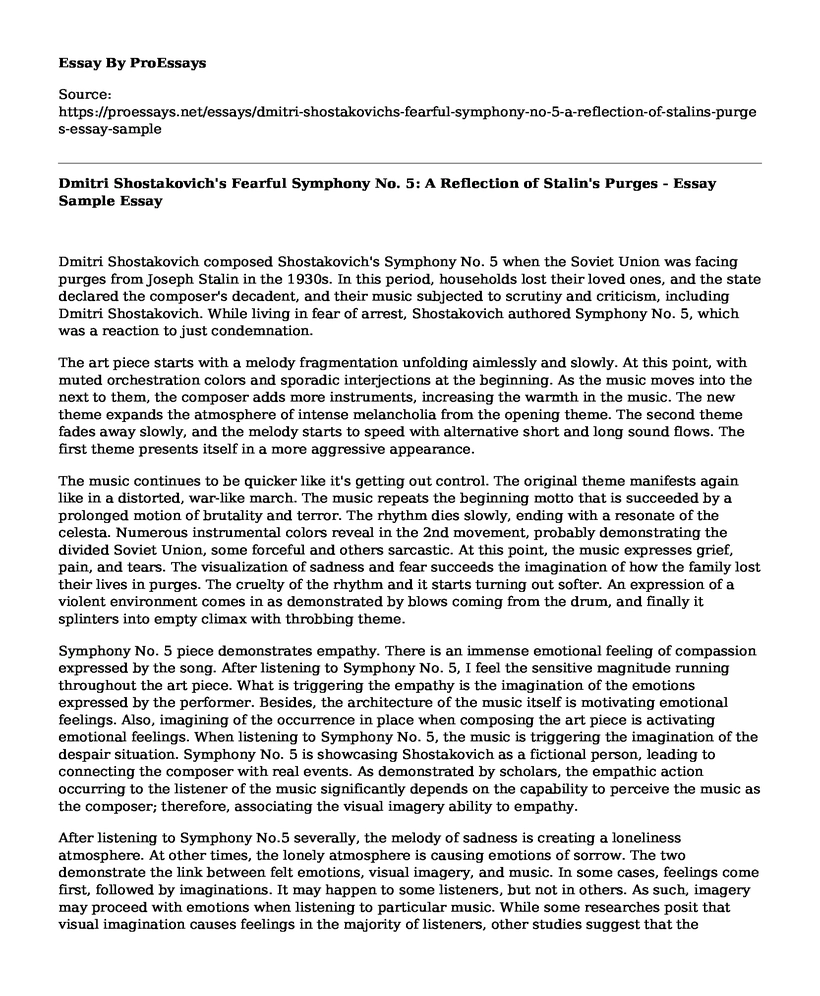Dmitri Shostakovich composed Shostakovich's Symphony No. 5 when the Soviet Union was facing purges from Joseph Stalin in the 1930s. In this period, households lost their loved ones, and the state declared the composer's decadent, and their music subjected to scrutiny and criticism, including Dmitri Shostakovich. While living in fear of arrest, Shostakovich authored Symphony No. 5, which was a reaction to just condemnation.
The art piece starts with a melody fragmentation unfolding aimlessly and slowly. At this point, with muted orchestration colors and sporadic interjections at the beginning. As the music moves into the next to them, the composer adds more instruments, increasing the warmth in the music. The new theme expands the atmosphere of intense melancholia from the opening theme. The second theme fades away slowly, and the melody starts to speed with alternative short and long sound flows. The first theme presents itself in a more aggressive appearance.
The music continues to be quicker like it's getting out control. The original theme manifests again like in a distorted, war-like march. The music repeats the beginning motto that is succeeded by a prolonged motion of brutality and terror. The rhythm dies slowly, ending with a resonate of the celesta. Numerous instrumental colors reveal in the 2nd movement, probably demonstrating the divided Soviet Union, some forceful and others sarcastic. At this point, the music expresses grief, pain, and tears. The visualization of sadness and fear succeeds the imagination of how the family lost their lives in purges. The cruelty of the rhythm and it starts turning out softer. An expression of a violent environment comes in as demonstrated by blows coming from the drum, and finally it splinters into empty climax with throbbing theme.
Symphony No. 5 piece demonstrates empathy. There is an immense emotional feeling of compassion expressed by the song. After listening to Symphony No. 5, I feel the sensitive magnitude running throughout the art piece. What is triggering the empathy is the imagination of the emotions expressed by the performer. Besides, the architecture of the music itself is motivating emotional feelings. Also, imagining of the occurrence in place when composing the art piece is activating emotional feelings. When listening to Symphony No. 5, the music is triggering the imagination of the despair situation. Symphony No. 5 is showcasing Shostakovich as a fictional person, leading to connecting the composer with real events. As demonstrated by scholars, the empathic action occurring to the listener of the music significantly depends on the capability to perceive the music as the composer; therefore, associating the visual imagery ability to empathy.
After listening to Symphony No.5 severally, the melody of sadness is creating a loneliness atmosphere. At other times, the lonely atmosphere is causing emotions of sorrow. The two demonstrate the link between felt emotions, visual imagery, and music. In some cases, feelings come first, followed by imaginations. It may happen to some listeners, but not in others. As such, imagery may proceed with emotions when listening to particular music. While some researches posit that visual imagination causes feelings in the majority of listeners, other studies suggest that the opposite is exact.
Visualization of the Symphony No.5 is leading to aesthetic appeal. I find it appealing and soothing to listen to the piece. It is probably from my judgment point of view of the music. In most cases, the vividness and emotional chemistry cause the aesthetic reaction in the mind of the listener. However, it relies substantially on personal judgment. With this in mind, the role of music visualization in evoking cognitive and emotive processes is paramount. In the process of listening to Symphony No. 5, I realize that there is a positive correlation between the visual imagery and the level of engagement by a listener. It is paramount to note that emotional responses are coming first, followed by visual representation. Again, whether emotional Responses proceed with visual imagery, it hugely depends on interindividual characteristics and diversity when listening to music. When listening to the genre, the degree of consciousness varies. Many studies highlight that the inter-individual difference of the listener determines the amount of emotional awareness when listening to music.
The visual imagery of Symphony No.5 is inducing differing colors. The color and images evoked the mind by visualization results in the emergency of black and blue colors. The black color is emerging when the feeling of sadness is occupying the mind. The black color is reflecting or denoting the sorry state of the composer during the time of composing the genre. I visualize that the composer is expressing oppression and helplessness he underwent during purges. Also, the blue color is occupying the mind, especially when the melody appears calm and relaxed. The blue color is reflecting a serene environment of the ocean as it refracts the blue color of the sky. It is creating an image of quietness away from violence. Additionally, I'm visualizing fear and disturbance in the song. The theme in the music is demonstrating a threating environment.
Cite this page
Dmitri Shostakovich's Fearful Symphony No. 5: A Reflection of Stalin's Purges - Essay Sample. (2023, Jul 05). Retrieved from https://proessays.net/essays/dmitri-shostakovichs-fearful-symphony-no-5-a-reflection-of-stalins-purges-essay-sample
If you are the original author of this essay and no longer wish to have it published on the ProEssays website, please click below to request its removal:
- Analysis of The Wanderer Above a Sea of Fog (1818) by Caspar David Friedrich
- Theme Construction in Kurosawa's Dreams
- The Future of Theater Essay
- Documentary Films: Nonfictional Films to Preserve & Evolve - Essay Sample
- Retail: The Process of Selling Consumer Products to Clients - Essay Sample
- Music Listening Preferences: Examining Age, Country & Gender - Essay Sample
- Free Essay Sample on How Social Media Can Affect Women's Mental and Physical Health







